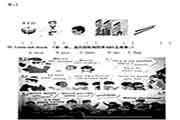四年级上册必需把握的英语语法知识有哪些?
【文章简介】小学英语考试复习关键的基本功只要三个方面的内容,不过便是语音、语法和单词。华宇考试网准备了以下内容,供各位参考。
 1、be动词与人称代词的搭配
1、be动词与人称代词的搭配
一、基本形式:am、are、is
第一人称I+am (注重:“I”不管什么时候都要大写,不论位于句首照旧句中)
例:I am a beautiful girl. I am twenty.
第二人称you+are; 一人称单数we+are; 三人称单数they+are 其他单数名词+are
(注重:第二人称单单数同形,都为you)
例:You are my good friend. We are in the same class.
They are on the road. The books are on the desk.
第三人称he(男) +is ; she(女)+is; it(不是人)+is;其他双数名词+is
例:He\She is a good student. It is a white cat.
A dog is on that street.
二、基本句式变换
例:I am(not) from London.
My eyes are(not) small.
My hair is(not) long.
Am I a Chniese?
解答: 一定:Yes, you are.
否认: No, you aren’t.
Is the cat fat?
解答:一定:Yes, it is.
否认: No, it isn’t.
注重:在一般疑难解答中,一定解答除I’m不行简写,否认解答都可简写。
2、一般疑难句及特别疑难句
句子基本是:简单陈说句,由简单陈说句变化成一定句,否认句,疑难句。疑难句是用来提出问题。英语中有四种疑难句: 一般疑难句、特别疑难句、选择疑难句和反意疑难句。咱们目前已经打仗到了前两种疑难句。
一、一般疑难句:
英语中要用 yes和no 往返答的疑难句叫一般疑难句。如:
1)Is it hot ? Yes, it is .\No, it isn’t. —— be动词指导
2)Is it a car ?Yes, it is .\No, it isn’t . —— be动词指导
3)Is this your ruler ?Yes, it is .\No, it isn’t .—— be动词指导
4)Do you like bananas ?——含实义动词
Yes, I like bananas. \ No, I don’t like bananas.或Yes, I do.\ No, I don’t
5)Can Tom see a dogl ?——含神态动词
Yes , Tom can see a dog.\No,Tom can’t see a dog.或Yes , he can.\ No,he can’t。
陈说句(一定句,否认句,一般疑难句)的变化规律:
1.一定句:2.否认句:3. 一般疑难句及肯否认解答
1) 主语+be动词+….1) 主语+be动词+not+….1)be动词+主语+…?
Yes, 主语+be动词./No, 主语+be动词+not.
I am a teacher.
I amnot a teacher.
Are you a teacher?
--Yes, I am./ No, I am not.
My mother is thin.
My mother is not /isn’t thin.
Is your mother thin?
--Yes, she is./ No, she isn’t.
They are friend.
They are not/aren’t friend .
Are they friend?
--Yes. they are./ No, they aren’t.
2) 主语+神态动词can+… 2) 主语+神态动词can+ not+….2)神态动词can+主语+…?
Yes, 主语+神态动词can/No,主语+神态动词can+ not
He can jump. He cannot/can’tjump. Can he jump?
--Yes,he can./ No, he can’t.
3)助动词do/does+主语+…. 动词真相+….动词真相?
Yes, 主语+助动词do/does. No, 主语+助动词do/does+not.
He likes to eat apples.
He doesn’t like to eat apples.Does he like to eat apples?
Yes,he does./ No,he doesn’t.
二、 祈使句:透露恳求、下令、倡议或劝说等的句子叫祈使句,主语you常省略。
1)、一定形式:一般以动词真相扫尾。 Open the door, please.
2)、否认形式:在句首谓语动词前加Don‘t。 Don‘t be late for class.
三、特别疑难句
用特别疑难词来提出问题的疑难句叫作特别疑难句。特别疑难词一般要放在句首。经常使用的疑难词有what、 who ,which 、how 等这些词都以wh扫尾(包含how)因此也叫作wh-question。特别疑难句要求解答详细内容。无法用yes或no解答。
构造:疑难词+一般疑难句。解答无法用yes / no(或相称于yes / no)解答的问句。答句的句式同一定句句式:如:
What can you see ? I can see a cat.
What do you like ? I like playing football
How old are you ? I’m ten.
3.总结:Be的用法口诀
I用am;you、we、they 都 用are;is连着he,she,it;
双数名词用is,单数名词全用are。
变疑难,往前提,句末问号莫抛弃。
变否认,更易,be后not莫遗忘。
疑难否认任你变,句首大写莫踌躇 。
3、神态动词can
can 在英语中有一个特别的名字,叫做神态动词,透露“能够”, “会”, “能力”后面要随着透露行动的动词。没偶然态和人称的改动。透露无法做什么的时候,后面加之 not为can not,或者缩写为can’t。问他人“能…吗?”要把can 放在句子前面,首字母要大写,句尾别忘加之问号。
例句:
—I can swing.I can draw.
—She can jump.He can play .
—We can touch .They can run.
—I can’t sing.You can’t see.
—She can’t dance.He can’t hear a car.
—Can you hear a dog?Can he hear a bus?
—Can Lucy write?Can you do it?
4、介词、连词和叹息词
1.介词:介词是一种实词,无法独自运用,必需在介词后面加之个名词或代词运用,作句子成分。
介词后面的名词(或相称于名词的别的词)叫做介词的宾语。介词和介词宾语合称为介词短语。介词短语在句中可作壮语、定语或表语。
介词如: in 在…内里on在…上面under在…下面等。
in the classroom
in the box
in the hall
on the road
on the desk
on the floor
under the table
under the bed
under the chair
2.连词:连词是用来连接词与词、短语与短语、句子与句子等的词叫连词。连词是一种实词,在句子中无法独自作句子身分。连词分两类:一类叫等立连词,另外一类叫附属连词。
(1). 等立连词是用来连接一律的词、词组和分句的。等立连词有很多,咱们目前只学到了and和but,其他的当前学到再介绍。
如:A and B ; blue and white ;an apple and a banana;a car and a bus;This is a lorry and that’s a drill.
(2).叹息词: 透露语言人的某种情感(诧异,兴奋,苦楚等)的词叫叹息词。叹息词后经常使用叹息号。经常使用的叹息词有:oh(透露惊讶或苦楚),ah(透露惊讶或满足),hello(常被用来打号召相称于汉语的“喂!”),well(透露诧异,无法)
5、 双数句和单数句:
口诀:双数句子变,改动划定规矩要记着。名词代词要改动,am, is要变are。
this, that酿成啥,these, those来替它。he, she, it要变啥,所有变they不用怕。
I要变we莫落下,名词后面把s/es加。名前冠词去失落它,其余身分原样加。
详细注重下面的六因素:
1.双数主格人称代词要酿成相对应的单数主格人称代词,即I→we; you→you; she, he, it→they。
如: She is a girl.→They are girls.
2. am, is要变成are。
如: I‘m a student. →We are students.
3.不定冠词a, an要去失落。
如: He is a boy. →They are boys.
4.普通双数名词要变成单数形式。
如: It is a cat. →They are cats.
5.唆使代词this, that要变成these, those。
如: This is a book.→These are books.
6. man, woman作定语润色可数名词时,要在 ”数”上与被润色名词坚持分歧。但其他名词润色名词透露 ”性子”时,不作改动。如:
He is a man doctor.→They are men doctors.
This is an apple tree.→They are apple trees.
